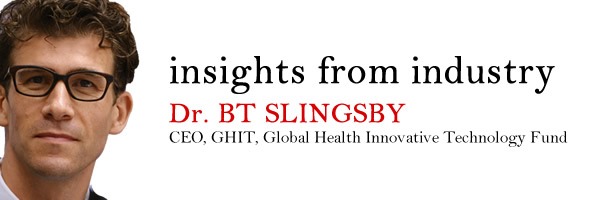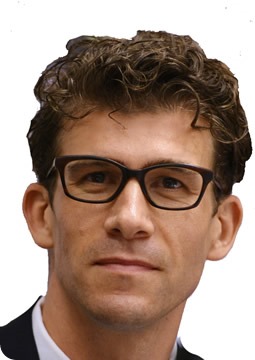
How many people suffer from infectious diseases like malaria, TB and neglected diseases?
Nearly 3.3 billion people, a little less than half of our world’s population, are at risk of malaria, TB and what we call “neglected tropical diseases”—diseases caused by worms, parasites, viruses and bacteria like Chagas disease, river blindness, elephantiasis, sleeping sickness, etc.
In fact, six out of 10 of the world’s poorest people die from these diseases every single year. And for those who manage to survive these diseases, they endure repeated bouts of serious illness, which affects their ability to provide for their families, ultimately keeping whole societies mired in poverty.
Why the need for the GHIT Fund? There seem to be a lot of partnerships out there already.
Despite the enormous burden these diseases cause, the research and development to treat, prevent and diagnose them are just not there, or if they exist, the people who need them can’t afford them. Of course, this is partially because of the challenging parasitology, virology and biology of infectious diseases, but it’s also because a failure of the market to develop products that likely provide little or no immediate return. And that’s where the need for the GHIT Fund lies.
We’re partnering with the Japanese government, a consortium of Japanese pharmaceutical companies, and the Bill & Melinda Gates Foundation to support the R&D that’s needed to develop new tools for these diseases, which otherwise might not get funded.
And with that partnership, we’re not only bringing a significant new source of funding to the fight against infectious diseases, and developing other new partnerships between the public and private sector to develop these tools—we’re also introducing new technological innovation that Japan is famous for.
We believe that infectious diseases are global issues that can only be solved by broadening and deepening international R&D partnerships between the public and private sectors. The challenges of developing these much needed tools are just too great for any one pharmaceutical company, research institution or country to confront by itself.
Please can you outline the research and development projects the GHIT Fund has invested in to tackle these diseases?
We just announced grants of US$5.7 million for six global partnerships working on novel drugs and vaccines for malaria, TB and Chagas disease, which together afflict one in seven of the world’s population.
One went to the Research Institute for Microbial Diseases at Osaka University, the Medical Center for Translational Research at Osaka University Hospital, and to Gulu University in Uganda to test their new malaria vaccine which recently showed efficacy against severe malaria—it’s a promising new candidate for a disease that desperately needs a vaccine.
Another one for malaria went to Ehime University and the biotech company CellFree Sciences, both in Japan, as well as the PATH Malaria Vaccine Initiative in the US, to identify novel targets of immunity for a vaccine that could support the goal of eventually eradicating malaria.
The biggest award went to the Medicines for Malaria Venture in Geneva and Takeda in Japan to study a promising new anti-malarial drug. So many of our best malaria drugs no longer work as the malaria parasite becomes resistant to them, so we really need new and more effective drugs. MMV and Takeda also received a grant for another malaria compound that’s in earlier stages of development.
GHIT is also investing in a novel vaccine candidate for TB that’s being co-developed by the National Institute of Biomedical Innovation and Create Vaccine Co., Ltd. in Japan, and Aeras in the US. This vaccine is actually the first to target the patient’s mucous membranes to keep TB from entering the lungs. Although a current vaccine for TB exists, it’s been around for almost 90 years and it doesn’t work well enough in teenagers and adults, who have the highest burden of TB.
The last grant is funding an innovative drug discovery initiative for Chagas disease, which is an infection caused by a parasite that can lead to cardiovascular disorders and even death. It affects mostly poor communities in South and Central America, and actually about 8 million people around the world, but there are no drugs to treat it. That grant goes to Eisai Co. Ltd in Japan and the Broad Institute of MIT and Harvard in the US.
Why is Japan getting involved in tackling these diseases through the GHIT Fund?
This is actually a perfect fit for Japan. In Japan, we have the highest life expectancy in the world. We have universal health coverage.
More than 70 percent of the Japanese public believes health should be the highest priority for government-supported development efforts. Health matters here. But the health of the world also matters. And healthy markets require healthy people.
Japanese leaders view our economic future as firmly tied to conditions in the developing world. They know that Japan can’t achieve its own economic objectives if the burden of disease in such a large part of the world continues to stunt the ability of billions of people to pursue prosperity.
Japan is a top three funder—second only to the US and the UK—of international development assistance, and we played a pivotal role in establishing and supporting the Global Fund to Fight AIDS, TB and Malaria. But until the launch of the GHIT Fund, the Government of Japan had not invested significantly in public-private partnerships to specifically focus on the discovery, development and delivery of global health technologies—technologies that can rid the world of these diseases that have burdened much of the world for too long.
What does Japan bring to improving global health?
Japan is a world leader in technology innovation and R&D spending. In fact, Japan is second only to the US in the number of new patents filed around the world.
Over the past two decades, Japan ranks second to the US in the discovery and development of new medicines; clearly a hands down leader in pharmaceutical innovation. For new chemical entities – the core to drug advancement – Japan ranks third after the US and UK. So the question may be not what Japan can bring, but rather how Japan can bring more to improving global health with more speed and impact.
What exactly is the contribution of Japanese pharmaceutical companies to these partnerships, and ultimately to saving lives?
Japanese pharma provide a really powerful engine for driving new partnerships for neglected diseases. They have a wealth of compounds and technologies, significant drug and vaccine manufacturing capacity, very advanced clinical and pre-clinical testing capabilities, and decades of experience guiding breakthrough discoveries from basic research to approval product.
We’re already pairing established product development partnerships around the world with these Japanese pharma firms to screen the company’s existing compounds, diagnostics and vaccines for new tools to fight these diseases. And our member companies are making available to infectious disease fighters some of the world’s richest and most diverse collections of pharmaceutical compounds.
Already, there’s a lot of excitement in the global health R&D community that these entirely new libraries of compounds can be opened up and screened for their potential to save lives. Our focus is on ensuring their availability to the people who need them most—not on creating profits for our partners.
Where can readers find more information?
http://ghitfund.org/
About Dr. BT Slingsby
 BT Slingsby is CEO of the Global Health Innovative Technology Fund. Before his position at GHIT Fund, he was involved in the founding of for-profit and non-profit entities in the US and Japan and was responsible for global access strategies for Eisai Co. & Ltd.
BT Slingsby is CEO of the Global Health Innovative Technology Fund. Before his position at GHIT Fund, he was involved in the founding of for-profit and non-profit entities in the US and Japan and was responsible for global access strategies for Eisai Co. & Ltd.
He also was active in healthcare research, with over 50 published peer-reviewed articles in journals including the Lancet, Journal of Public Health, and the Journal of General Internal Medicine.
Dr. Slingsby graduated from Brown University, earned his Masters and Doctorate from Kyoto University, The University of Tokyo, and received his Medical Doctorate from The George Washington University.